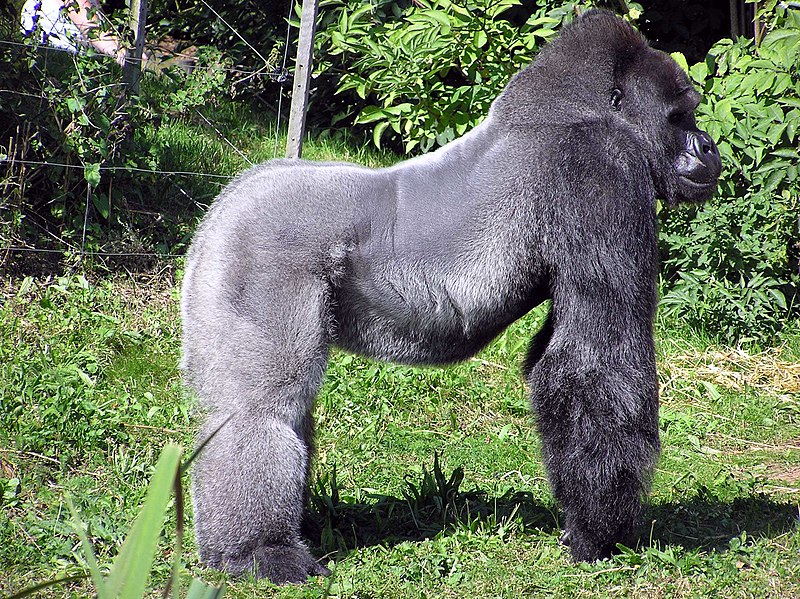 |
*Photograph of a Western Lowland Gorilla at a Public Zoo in England |
Hierarchy of Classification
Kingdom: Animalia
Phylum: Chordata
Class: Mammalia
Order: Primates
Family: Hominidae
Genus: Gorilla
Species: gorilla
Kingdom: Animalia
Phylum: Chordata
Class: Mammalia
Order: Primates
Family: Hominidae
Genus: Gorilla
Species: gorilla
Introduction
Gorilla gorilla, also known as the Western Lowland Gorilla, is one of the largest primate species in the World. Their natural habitat is in several central African countries. Sadly, the land is being consumed by humans and invaded by the Ebola virus. Currently G. gorilla is on the endangered species list and many of them now find their homes in habitat sanctuaries or public zoos.
Taxonomy
G. gorilla and Homo sapien ancestors, according to evolutionary scientists, shared a common ancestor about 8 million years ago before they separated on the track of evolution. Male G. gorilla is between 300-600 lbs and females are around half that size. Their hair is coarse and mostly black, but male G. gorilla develops a distinct silver color along their back and other parts of their body. Males develop this silver color at about the age of 11 years old and are termed 'Silver Back".
Life Cycle
G. gorilla usually has male bachelor groups and groups that consist of one dominant 'Silver Back' male with several females. The dominant "Silver Back" Western Lowland Gorilla impregnates the females and the gestation period is about 8.5 months. G. gorilla females care for their infants for many years. The first 3-4 years of the young G. gorilla life is spent attached to its mother. When the young G. gorilla start roaming independently they start interacting with other adult Western Lowland gorillas more, peers their age, and the ecosystem around them. By the time they are 11-12 years old, they are seen as developed adults by the group and usually transfer into all male groups. The only way they can leave this bachelor group is to become a dominant 'Silver Back' Western Lowland Gorilla and then have female gorillas to bond and procreate with.
Virus Complication
The Ebola virus is a deadly virus with up to 90-95% of G. gorilla dieing if they catch the virus. Humans also die from this virus with about an 80% death rate. Research is currently being done to develop a vaccination to help save both Western Lowland Gorillas and humans. In labs it has been discovered that a vaccination is working on monkeys, so hopefully soon
there will be one for us and G. gorilla!
Gorilla gorilla, also known as the Western Lowland Gorilla, is one of the largest primate species in the World. Their natural habitat is in several central African countries. Sadly, the land is being consumed by humans and invaded by the Ebola virus. Currently G. gorilla is on the endangered species list and many of them now find their homes in habitat sanctuaries or public zoos.
Taxonomy
G. gorilla and Homo sapien ancestors, according to evolutionary scientists, shared a common ancestor about 8 million years ago before they separated on the track of evolution. Male G. gorilla is between 300-600 lbs and females are around half that size. Their hair is coarse and mostly black, but male G. gorilla develops a distinct silver color along their back and other parts of their body. Males develop this silver color at about the age of 11 years old and are termed 'Silver Back".
Life Cycle
G. gorilla usually has male bachelor groups and groups that consist of one dominant 'Silver Back' male with several females. The dominant "Silver Back" Western Lowland Gorilla impregnates the females and the gestation period is about 8.5 months. G. gorilla females care for their infants for many years. The first 3-4 years of the young G. gorilla life is spent attached to its mother. When the young G. gorilla start roaming independently they start interacting with other adult Western Lowland gorillas more, peers their age, and the ecosystem around them. By the time they are 11-12 years old, they are seen as developed adults by the group and usually transfer into all male groups. The only way they can leave this bachelor group is to become a dominant 'Silver Back' Western Lowland Gorilla and then have female gorillas to bond and procreate with.
 |
| *Photograph of a female and her cub (Western Lowland Gorilla) |
 |
| *Ebola Virus Microscopic Photo |
The Ebola virus is a deadly virus with up to 90-95% of G. gorilla dieing if they catch the virus. Humans also die from this virus with about an 80% death rate. Research is currently being done to develop a vaccination to help save both Western Lowland Gorillas and humans. In labs it has been discovered that a vaccination is working on monkeys, so hopefully soon
there will be one for us and G. gorilla!
References
Cosmos, R. 2008. Gorilla gorilla. Animal Diversity Web. Retrieved on November 30th, 2010: http://animaldiversity.ummz.umich.edu/site/accounts/information/Gorilla_gorilla.html
Lang, K. (2005). Gorilla Gorilla. Primate Info Net. Retrieved on November 30th, 2010: http://pin.primate.wisc.edu/factsheets/entry/gorilla
Popovich, D., Jenkins, D., Kendall, C., et al. (1997). The Western Lowland Gorilla Diet Has Implications for the Health of Humans and Other Hominoids. American Society for Nutritional Services. Vol. 127 no. 10, 2000-2005. Retrieved on November 30, 2010: http://jn.nutrition.org/content/127/10/2000.full
Patterson, R. (2007). Evolution Exposed Chapter 10: The Origin of Humans. Answers in genesis. Retrieved on November 30th, 2010: http://www.answersingenesis.org/articles/ee/origin-of-humans
Unknown Author (2010). Ebola vaccine & western gorillas. Animal Research. Retrieved on December 1st, 2010: http://www.animalresearch.info/en/medical/veterinary/ebola
Unknown Author (2010). Western Lowland Gorilla. National Geographic. Retrieved on November 30th, 2010: http://animals.nationalgeographic.com/animals/mammals/lowland-gorilla.html
(Word Count: 373)
(Word Count: 373)